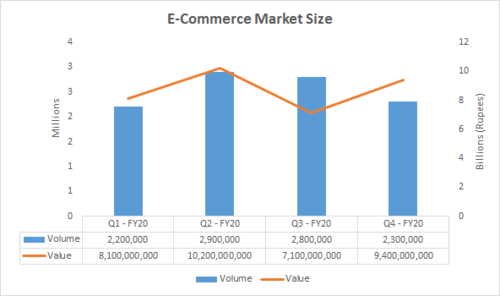COVID-19 hardships turn boon as Pakistan's E-commerce grows by 79pc
- Despite the COVID-19 pandemic, Pakistan’s e-commerce market witnessed growth due to a year-on-year rise in the use of digital payment methods.
The e-commerce market in Pakistan witnesses a year-on-year growth of 78.9% and 33.3% in volume and value respectively in 2020, according to the latest e-commerce data by the State Bank of Pakistan (SBP).
The COVID-19 pandemic has essentially transformed how businesses interact with their consumers. While many wholesale and retail businesses have shifted online to reach their target market through e-commerce, others have used social media and the rising power of influencers to step into the arena of digital marketing.
State Bank’s e-commerce data compiled by DYL Ventures shows that e-commerce transactions fell by ~500,000 orders in the last quarter of FY2020 as compared to the 3rd quarter of FY2020.
However, e-commerce revenue increased sharply by Rs.2.3 billion to Rs.9.4 billion in the last quarter of FY2020, brining the yearly e-commerce revenue to Rs.34.8 billion.

Number of e-commerce merchants who are registered with banks have also increased by more than 30%, summing up to 1707 as of June 2020.
A major factor that supported the growth of the e-commerce sector has been the rise in the use of digital payments. E-commerce transactions by debit, credit and prepaid cards in FY2020 increased by around 88% and 18% in volume and trade as compared to the last year.
E-commerce transactions by debit, credit and prepaid cards were also the highest during the 2nd quarter of FY2020, when the COVID-19 lockdown was imposed on businesses and customers could not physically visit the stores.

However, online transactions have fallen after the lockdown was lifted in Pakistan, indicating the need to develop more long-term policies in the retail and banking sectors to complement this growing need.
In addition to this, most customers in Pakistan also rely heavily on Cash-on-Delivery (COD) due two main factors: lack of trust in the online retailers and higher taxes imposed on the already inaccessible digital payment options. Many banks in Pakistan either do not allow online payments through debit cards or charge an additional amount on debit card payments. Brick and mortar retailers also add on an additional 2.5% fee on the use of credit/debit cards, which further dis-incentivizes customers from shifting to digital payment systems.
Hence, recent trends indicate that accelerating growth in Pakistan’s e-commerce sector is contingent on improving access to digital payment systems and reducing both direct and indirect costs associated with this payment method.























Comments
Comments are closed.